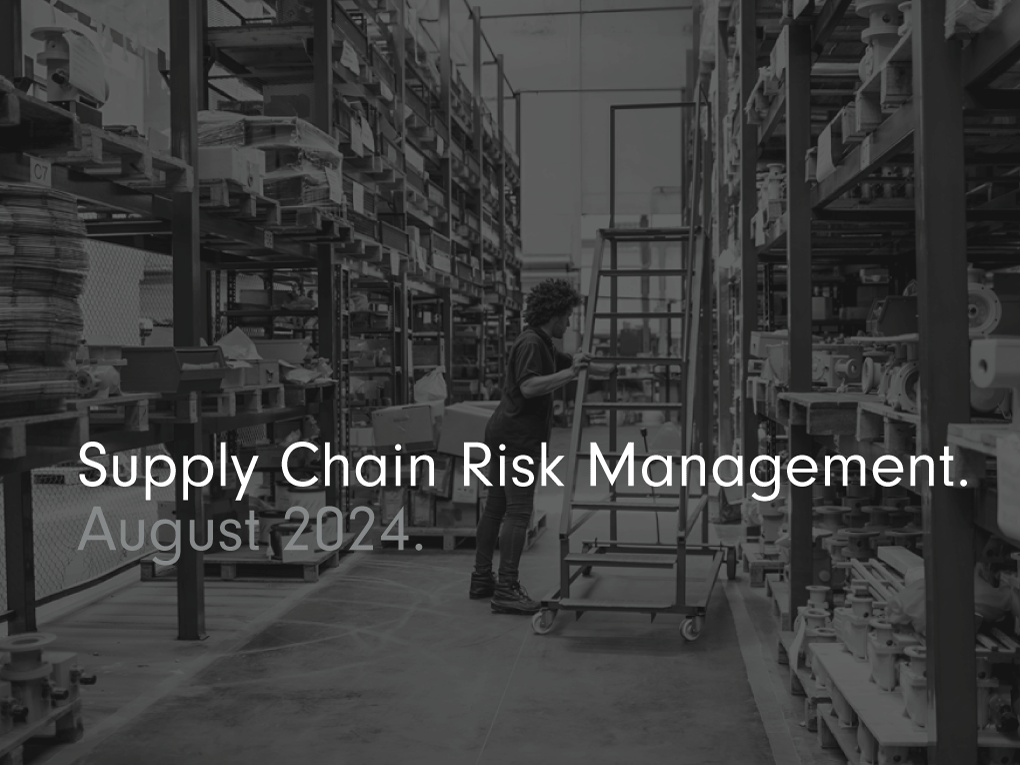Supply Chain Risk Management: Why Proactivity Beats Reactivity.

In today’s world, the supply chain is key for businesses. It’s about getting raw materials and delivering finished products. But there are risks like storms, issues with suppliers, and political problems. Despite this, many companies only fix problems after they happen. This doesn’t work well today because things change too fast.
What is Risk Management in the Supply Chain?
Risk management in supply chains means finding, assessing, and reducing potential risks that could stop goods and services from flowing smoothly. This involves checking for weak spots, making backup plans, and regularly keeping an eye on risks.
By managing risks ahead of time, businesses can protect their operations and become more resilient to unexpected disruptions. Good risk management helps companies keep up with customer needs, protect their reputation, and run more efficiently, giving them an edge over competitors.
The New Era of Supply Chain Risk Management.

Proactive vs. Reactive Approaches.
A reactive approach to supply chain risk management means dealing with issues as they arise. While this can be effective in some situations, it often leads to higher costs, longer recovery times, and significant operational disruptions. In contrast, a proactive approach involves anticipating potential risks and implementing measures to mitigate them before they occur. This shift from reactive to proactive risk management is crucial for building a resilient supply chain.
The Power of Technology and Data Analytics.
Using tech, data analysis, and live tracking can change how we manage risks in supply chains. Tools like AI and machine learning help spot and predict problems by looking at lots of data from different places. These technologies help business operations:
- Monitor Supplier Risks: AI platforms can check if suppliers are financially stable and warn about possible risks early on.
- Predict Natural Disasters: By analyzing weather patterns and historical data, AI can forecast natural disasters and suggest alternative logistics routes.
- Optimize Inventory Management: Real-time data analytics helps keep the right amount of stock, avoid too much or too little, and ensure everything in the supply chain runs smoothly.
Stakeholder Collaboration and Transparent Communication.
An effective supply chain risk management strategy requires collaboration between all stakeholders, including suppliers, logistics providers, and customers. Transparent communication channels ensure that everyone involved is aware of potential risks and can contribute to mitigation efforts. Strategies to enhance collaboration and communication include:
- Supplier Partnerships: Establishing strong relationships with suppliers can lead to better cooperation during disruptions.
- Shared Risk Assessments: Regular check-ins with important team members help find weak spots and make plans together to reduce risks.
- Integrated Communication Platforms: Using platforms that allow instant messaging helps everyone stay updated on any changes or risks in the supply chain.
From Risk Avoidance to Risk Tolerance.
The traditional mindset of avoiding risks at all costs is evolving. Modern supply chain managers recognize that taking calculated risks can drive innovation and resilience. This shift in mindset involves:
- Accepting Uncertainty: Understanding that some level of risk is inevitable and preparing to handle it effectively.
- Encouraging Innovation: Making space for trying new things and fresh ideas, even with some risk, can help create better and stronger ways to manage supply chains.
- Building Flexibility: Developing flexible supply chain strategies that can adapt to changing circumstances and recover quickly from disruptions.
Implementing a Proactive Supply Chain Risk Management Model.

Steps to Build a Resilient Supply Chain.
- Conduct a thorough supply chain risk assessment to identify potential vulnerabilities and their impact on operations.
- Use software to check for risks with suppliers, political issues, and the environment.
- Invest in AI and data analytics tools to monitor and predict potential disruptions in real-time.
- Use software to manage supply chain risks better. It helps find and reduce supply chain risks easily.
- Foster strong relationships with suppliers and logistics providers to ensure a cohesive risk management strategy.
- Use integrated communication platforms to maintain transparency and facilitate real-time information sharing.
- Create detailed contingency plans for various risk scenarios, including natural disasters, supplier failures, and geopolitical events.
- Regularly review and update these response plans to ensure their effectiveness.
- Provide training for supply chain managers and staff on risk mitigation best practices and technologies.
- Encourage a culture of continuous improvement and innovation within the supply chain team.
- Use real-time monitoring tools to track supply chain performance and identify emerging risks.
- Keep checking and improving your risk management as you learn more.
Boosting Supply Chain Resilience with Warehouse Management Systems.

A Warehouse Management System (WMS) is key to better managing supply chain risks. It gives tools that help see, control, and make warehouse operations more efficient. Here’s how a WMS helps lower risks in the supply chain:
- Real-Time Inventory Tracking: A WMS keeps an eye on inventory all the time. This helps businesses quickly spot any differences and avoid having too little or too much stock. This makes the supply chain more reliable and less prone to problems because of inventory issues.
- Better Use of Space: A WMS helps use warehouse space better by looking at how fast inventory sells and how much storing it costs. This not only makes operations smoother but also reduces risks like paying too much for storage or having outdated products.
- More Accurate Orders: Automated picking and packing mean fewer mistakes in orders. This lowers the risk of unhappy customers and returns, making the supply more dependable.
- Improved Demand Forecasting: A WMS works with sales and forecasting tools to better predict sales changes. This helps adjust inventory to match predicted sales, managing risks from supply and demand mismatches.
- Disaster Recovery Planning: A WMS keeps detailed records of where inventory is and how it moves. If there’s a problem, these records help fix things faster, reducing downtime.
- Managing Suppliers: A WMS can connect with suppliers’ systems to see how reliable they are. This helps businesses manage risks from too much reliance on suppliers or delays, leading to smarter decisions.
Using a WMS helps businesses strengthen their supply chain and better manage risks, leading to a more solid operation.
The Competitive Advantage of Proactive Supply Chain Risk Management.

By adopting a proactive approach to supply chain risk management, businesses can gain a competitive advantage in several ways:
- Enhanced Resilience: A resilient supply chain can quickly adapt to disruptions, minimizing their impact on operations and customer satisfaction.
- Cost Savings: Proactively identifying and mitigating risk factors can reduce the costs associated with supply chain disruptions, such as expedited shipping and inventory shortages.
- Improved Reputation: Businesses that consistently deliver products on time, even during disruptions, build trust and loyalty with customers.
- Innovation and Growth: Encouraging smart risks and new ideas can improve supply chains and create new business chances.
Case Study: Apple - Proactive Supply Chain Risk Management.
Apple Inc. shows how to manage supply chain risks well by being resilient and innovative. The company spends a lot on tech and data analysis to keep an eye on its complex supply chain. This lets them spot problems in real-time. For example, during the COVID-19 pandemic, Apple used its strong analytics to predict supply chain issues and quickly change its manufacturing processes.
Apple works closely with its suppliers to manage risks together, making sure they can quickly deal with any new problems. This approach has not only kept Apple’s products available but also strengthened its image as a tech industry leader. This has helped Apple keep its customers loyal and continue to grow in the market.
Conclusion.
In today’s fast-changing world, managing risks in your supply chain is crucial. It’s not just a good idea; it’s a must. Use technology, work well together, and take some risks. This way, your supply chain can stay strong even when things get tough.
Want to improve your supply chain risk management? Start using these tips and see your business become more flexible, strong, and able to stand out in the global market.
Need more help or advice tailored to what you need? Get in touch with our experts. We’re here to help you handle risks better.
Frequently Asked Questions.
Proactive supply chain risk management means spotting and reducing risks before they cause problems. This method aims to predict issues and create plans to stay strong, instead of just fixing problems when they happen.
Technology like AI and data analytics helps improve supply chain risk management. It allows real-time monitoring and predictions. These tools help businesses find weak spots and predict problems. This leads to faster and better decision-making.
Working with stakeholders like suppliers and logistics providers is key to managing risk well. Good relationships help clear communication and information sharing. This leads to better risk management and improved supply chain performance.
A Warehouse Management System (WMS) tracks inventory in real-time, managing supply chain risks. It makes better use of space, boosts order accuracy, and forecasts demand more effectively.
A WMS also helps in disaster recovery and supplier management. Its features streamline warehouse operations, cutting down on errors and disruptions. Essentially, a WMS strengthens the supply chain, making it more resilient to risks in an unpredictable world.